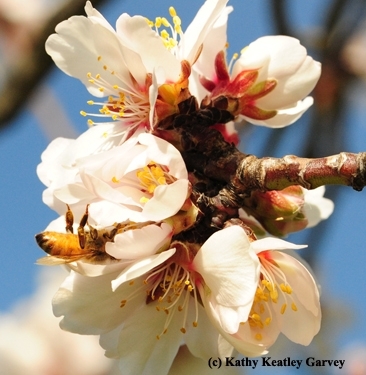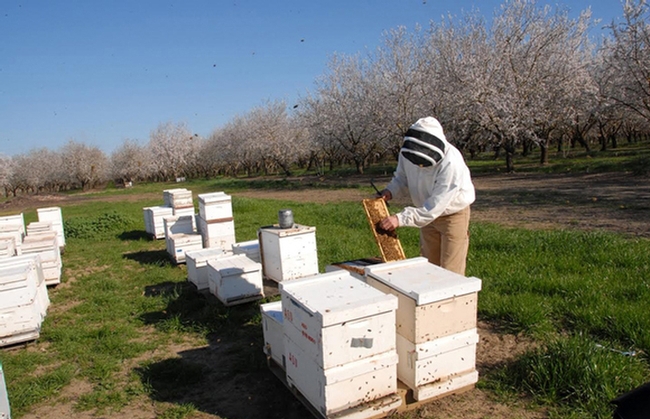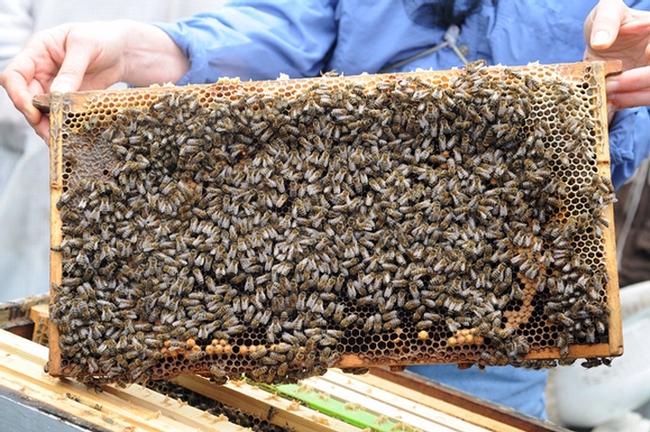
That's a short-cut for "Bee Best Management Practices."
The Almond Board of California today unveiled its long-awaited "Honey Bee Best Management Practices for California Almonds."
It's an important document because it is aimed at protecting the honey bees that pollinate California's 900,000 acres of almonds. Last spring some 80,000 colonies died because pesticides reached them before the beekeepers did, that is, before the beekeepers could remove them from the orchards after pollination season. It amounted to a lack of communication.
The editors spelled out the importance of the document at the onset:
"Honey bees are essential for successful pollination of almonds and the long-term health of the California Almond industry. Why should almond growers — and all parties involved in almond pollination — care about healthy, strong bees? First, bees are a valuable resource and almond production input, and the time they spend in almonds impacts hive health throughout the year, from the time they leave almond orchards until they return the next season. Second, although almonds are only one of more than 90 foods that rely on pollination by bees, because of its size and number of bees needed, the California Almond industry is increasingly being watched by the public on matters related to the health and stability of honey bee populations. Of particular concern at this time is how to manage the use of pest control materials in ways that minimize their possible impact on honey bees. It is important that growers of all crops implement best management practices to support bee health, and for those whose crops rely on honey bee pollination, to consider honey bee health not only during the pollination season, but during the entire year."
The Bee BMP zeroed in on four key precautions:
1. Maintain clear communication among all parties involved, particularly on the specifics of pesticide application.
2. If it is necessary to spray the orchard, for instance with fungicides, do so in the late afternoon or evening.
3. Until more is known, avoid tank-mixing products during bloom.
4. Avoid applying insecticides during bloom until more is known about the effects on honey bees, particularly to young, developing bees in the hive. Fortunately, there are several insecticide application timing options other than bloom time treatments.
The document advocates that a clear chain of communication be established among all parties involved in pollination and pest management during almond bloom. This should definitely help prevent bee losses before, during and after the pollination season.
Three officials from the Almond Board of California did an excellent job editing the document and drawing input from the industries:
- Bob Curtis, associate director, Agricultural Affairs
- Gabriele Ludwig, associate director, Environmental Affairs
- Danielle Veenstra, specialist, Agricultural and Environmental Affairs
They received input from 10 contributing editors and reviewers:
- Gene Brandi, Gene Brandi Apiaries
- Jackie Park-Burris, Jackie Park-Burris Queens
- Orin Johnson, Johnson Apiaries
- Gordon Wardell, director, Pollination Operations, Paramount Farming Company
- George Farnsworth, California Department of Pesticide Regulation
- Karen Francone, California Department of Pesticide Regulation
- Eric Mussen, Extension Apiculturist retired, UC Davis
- Thomas Steeger, Office of Pesticide Programs, U.S. EPA
- CropLife America
- Christi Heintz, Project Apis m.
You can download the document on the Almond Board of California website. (Look under "growers" at the top of the home page.)
Attached Images:

